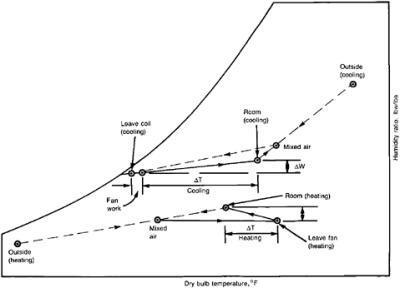HVAC Systems Design Handbook, Fourth Edition

By definition, air conditioning involves control of the air temperature, humidity, cleanliness, and distribution. It follows that an air-handling unit (AHU) of some kind is an essential part of an air conditioning system, though not necessarily of a heating-only system.
The function of the AHU is to provide air at a quantity, temperature, and humidity to offset the sensible and latent heat gains to the space (in the cooling mode) and the heat losses (in the heating mode), while maintaining the required temperature and humidity in the space. This can be most clearly shown on a psychrometric chart (Fig. 11.1). A typical cooling design room condition is 78 F dry-bulb (db) temperature and 50 percent RH. For illustration, a load of 120,000 Btu/h sensible and 30,000 Btu/h latent cooling is assumed. Then, for an assumed 20 F temperature difference between the room and supply air temperatures (58 F supply air), the design flow rate of air, designated CFM, in cubic feet per minute (cfm) will be

| (11.1) | |
where 1.08 is the air factor in Btu/h, cfm, F.
The change in specific humidity ? w may be calculated as follows:
| (11.2) |  |
The point defined by these two differential values can be plotted on the chart, as shown. The validity of this point must be verified, based on the cooling coil capability and the AHU arrangement, as discussed in Sec. 3.6. For a draw-through arrangement (i.e., with the supply fan downstream...
